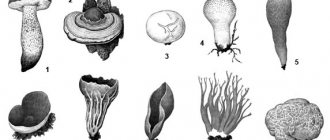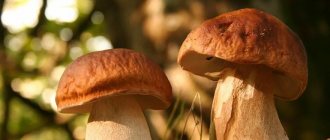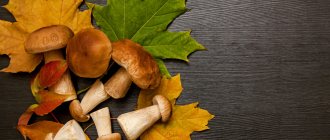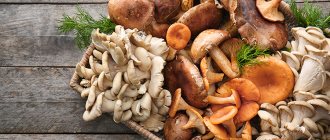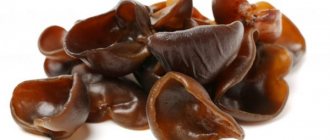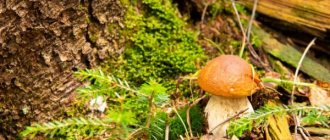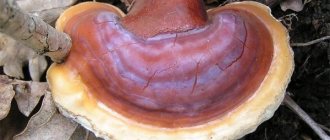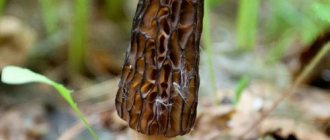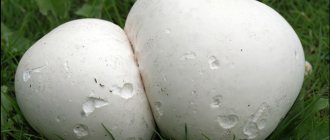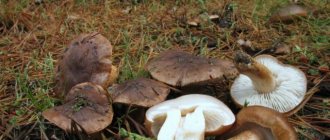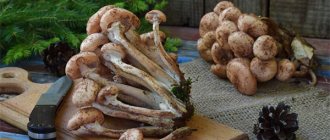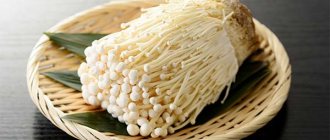The common oiler grows only in symbiosis with pine, therefore it is common in coniferous or mixed forests. Mycorrhiza with the root system of the coniferous tree played an important role in the composition of the fungus. Oil can is considered one of the complex chemical substances. The benefits and harms of butter oil cannot be assessed unambiguously. The main part of the microelements of the fruiting body is valuable for humans, but there are a number of contraindications.
Chemical composition and calorie content of butter
The pulp of fresh and processed mushrooms contains a huge amount of valuable substances. Among the main ones are:
- ascorbic acid and vitamin PP;
- vitamins A and B;
- iron, phosphorus and zinc;
- copper and iodine;
- manganese and potassium;
- fiber;
- amino acids;
- mono- and disaccharides.
Butter mushrooms contain a lot of amino acids and vitamins.
Most of the protein in the product is up to 2.4 g. Carbohydrates in butter milk are present in a volume of 1.7 g, and fats are only 0.7 g. The nutritional value of mushrooms is very low - only 19 calories per 100 serving G.
Where, when and under what conditions do they grow?
The most suitable climate for growing blackberries is the temperate climate of the middle zone. However, this mushroom can also be found in both more northern and southern regions and even in subtropical forests. The favorite habitat of the hedgehog is dry coniferous forests growing on sandy soil or limestone. Depending on the variety, such mushrooms can grow either singly or in clusters. The same applies to places of growth - one species can be found only in the soil, while the other chooses old dry trees, stumps, dead wood and even loose hollows as a place of growth. Collection times may also vary: from mid-June to early July, up to October - November.
Did you know? The motley hedgehog is used in Norway as a raw material for obtaining a bluish-green dye for sheep's wool.
What are the benefits of boletus mushrooms for humans?
Butternuts are valued for their pleasant crunchiness and mild taste. But, in addition, they have numerous beneficial properties. In particular, mushrooms:
- improve the functioning of the immune system and increase the body’s resistance to viral diseases;
- help fight inflammation as they prevent the proliferation of pathogenic bacteria;
- improve liver function due to lipid content and normalize intestinal motility;
- have a positive effect on the reproductive system and increase libido in men;
- lower blood glucose, therefore beneficial for diabetes mellitus;
- strengthen the walls of blood vessels and prevent the development of atherosclerosis and heart disease;
- lower cholesterol levels and help fight the tendency to blood clots;
- increase hemoglobin and prevent anemia;
- accelerate regeneration processes in tissues;
- have a beneficial effect on brain activity and the nervous system.
Since boletus improves metabolic processes and stimulates cellular renewal, consuming them is useful for the prevention of cancer.
For women
The beneficial properties of boletus mushrooms for women include, first of all, a positive effect on the nervous system. Mushrooms help cope with stress and neuroses and regulate night sleep. You can also use them in case of malfunctions of the reproductive system; they will normalize hormonal levels and help increase libido.
Mushrooms are useful not only for general health, but also for maintaining youth and beauty. With regular use, they improve skin tone and strengthen hair.
Oil butter evens out the emotional background and improves reproductive functions
Important! Oils regulate blood pressure and relieve headaches. Including them in your diet is useful if you are prone to migraines.
For men
Representatives of the stronger sex are recommended to consume boletus to prevent cardiovascular diseases. Mushrooms improve the tone of blood vessels and heart muscle, reducing the risk of early heart attacks and strokes. Since fruiting bodies contain a lot of protein, they can be eaten to gain and maintain muscle mass.
Mushrooms protect the male reproductive system from failures. If you add boletus to your diet from time to time, there will be no problems with potency.
During pregnancy
Healthy oils are not recommended for use by women who are pregnant. Despite all their valuable properties, mushrooms can cause great harm to the expectant mother or baby in the womb. Even if a woman does not suffer from allergies or chronic diseases, butter can always turn out to be stale, especially when salted or pickled. The potential danger of the product outweighs the benefits, so it is better to exclude mushrooms from the diet.
For nursing women
Women who are breastfeeding are advised to include boletus back into the menu only 6 months after giving birth. In the early stages, mushrooms will lead to digestive upset in a newborn; his sensitive intestines will not be able to absorb the product.
It is better not to eat boletus during pregnancy - possible poisoning is too dangerous
For children
Butter can be very beneficial for children. They saturate the body with vitamins and minerals, improve the functioning of the nervous system, and have a positive effect on intelligence and memory.
But at the same time, mushrooms are not offered to children under 7 years of age. Fruit bodies contain a substance called chitin, which is almost not digested by the body, and therefore can lead to flatulence, nausea and digestive disorders.
Attention! Mushrooms have certain contraindications. Before including them in your child’s diet, you should consult a pediatrician.
When losing weight
The low-calorie product can be consumed on a diet. It saturates the body with high-quality protein and quickly quenches the appetite, and does not affect the figure if taken in moderate dosages.
Recommended reading: Benefits of boiled beets for the body
It is even allowed to use a mono-diet on mushrooms. In this case, you need to eat no more than 300 g in boiled form per day. You can add some vegetables to the oils; be sure to drink more water. Continue the diet for no more than 2 days; if you eat only mushrooms for a long time, this will lead to poor digestion and constipation.
Low-calorie boletus can be eaten on a diet after boiling
Preparation
Before cooking the hedgehog mushroom, you need to carefully scrape off the remaining leaves and soil from it with a knife. Mushroom pickers also advise removing spines from large specimens, especially if you are going to pickle them - during heat treatment, the needles will fall off and ruin the appearance of the jar.
To boil blackberry mushrooms:
- Clean and rinse them under running water.
- Cut into pieces 1–1.5 cm.
- Fill with cold water.
- Bring to a boil and cook for 15–20 minutes.
To fry, take:
- 0.5 kg of mushrooms;
- 1 medium onion;
- 1 tbsp. l. vegetable oil.
Then:
- Boil the mushrooms as described above.
- Meanwhile, heat the pan.
- Pour oil on it and place the boiled product.
- Cook uncovered until the liquid has evaporated.
- Add chopped onion.
- When it becomes soft, cover the pan with a lid.
- Spread almost finished mushrooms over the surface with a thin layer of sour cream without stirring.
- When they darken and become soft, they are served.
Very young mushrooms can be placed raw in the pan.
IMPORTANT If blackberries are fried with other mushrooms, the characteristic bitterness will become almost invisible.
For marinating, prepare:
- half a kilo of mushrooms (you can take equal parts chanterelles and hedgehog mushrooms);
- 1 medium onion;
- 1 large clove of garlic;
- 1 tbsp. l. salt;
- 2 tbsp. l. vinegar (5%);
- 1 tbsp. l. vegetable oil;
- 10 black peppercorns;
- 1 cup (250 mg) boiling water + the same amount for scalding.
Then:
- Peel and rinse the mushrooms under running water.
- Pour boiling water over them, let stand for 15 minutes, drain in a colander and rinse with running water.
- Cut the onion into rings or half rings, or simply cut equally.
- Divide the garlic clove in half or chop into thin slices (in this case, the mushrooms will have a more pronounced garlic flavor).
- Place garlic and onion in the bottom of a sterile 720 ml jar, add salt and pepper, vinegar and oil, and 100 ml of boiling water (you will have more than half a cup left).
- Place mushrooms in a jar.
- Cover the top with a bay leaf and pour in the remaining boiling water (150 ml).
- Screw on the jar with a sterile lid, turn it over and shake it several times, and place it upside down until the lid retracts - this will take about an hour.
- Place the container with the product in the refrigerator or cellar.
IMPORTANT If you are afraid to put raw mushrooms in a jar, then do not scald them, but boil them.
To pickle hedgehog mushrooms, take:
- 1 kg of mushrooms;
- 2 tbsp. l. salt (without a slide);
- 3 bay leaves;
- 5 peas each of black and allspice;
- 3 buds of cloves;
- 2 cloves of garlic.
Then:
- Boil the peeled and washed mushrooms.
- Transfer them to a pickling container.
- Cut the peeled garlic into slices about 1 mm thick and sprinkle it on the mushrooms.
- Prepare a hot brine by boiling water with spices.
- Pour it over the mushrooms.
- Cover them and put them under pressure.
- After a day, place the hedgehogs in the refrigerator (without oppression).
- After another 24 hours, transfer to sterile jars and close them with sterile lids.
- It will take at least a week for the mushrooms to be properly salted.
ATTENTION! Salted mushrooms are prepared without vinegar, which prevents the growth of botulism bacteria, a life-threatening infection that develops in the absence of oxygen. Therefore, in this case, only plastic covers that allow air to pass through are used. You need to eat the contents of the jar within 3 months.
To freeze hedgehog mushrooms:
- Boil the mushrooms.
- Let the water drain, then dry them on a towel.
- Stuff plastic food bags tightly with them and tie them so that there is no empty space inside.
- Place the mushrooms in the freezer or freezer.
- In winter, when you want to cook a dish from them, throw the contents of the bag into a saucepan or frying pan without waiting for it to thaw.
Since mushrooms perfectly absorb all odors, keep them away from meat and fish products.
ATTENTION! Never refreeze a package of mushrooms that has already thawed.
To dry hedgehogs:
- Peel them and cut them into 1-1.5 cm pieces.
- Preheat the oven to 60 C.
- Place the mushrooms on a wire rack and place it in the oven, and place a baking sheet underneath.
- Dry with the door open for two days.
This process can be performed without the cost of electricity, simply by stringing blackberries on a nylon or canvas thread and hanging the bunch in the kitchen. The room must be dry and well ventilated.
Dried mushrooms can be ground in a coffee grinder. The resulting “flour” is added to soups or sauces based on it are prepared.
Are pickled boletus healthy?
For the winter, mushrooms are often marinated with spices and spices to extend their shelf life. Such snacks also have benefits; they contain a maximum of vitamins and beneficial microelements. In particular, pickled butter:
- strengthen the immune system and improve metabolic processes;
- accelerate digestion when the stomach is sluggish;
- relieve muscle pain and fight inflammation;
- improve blood composition and remove toxins;
- have a beneficial effect on the nervous system and brain function.
At the same time, you need to include them in your diet with caution - spices and vinegar in the product can be harmful for diseases of the digestive system. If you have serious problems with the kidneys, stomach or liver, then it is better to avoid pickled mushrooms.
Pickled boletus is beneficial if it is of high quality and fresh.
Advice! Even in the absence of contraindications, daily norms of no more than 100 g of product per day must be observed.
Use of boletus in medicine
Butter can be found not only in culinary recipes, but also in home medicine. Mushrooms effectively remove harmful substances from the body and have anti-inflammatory properties. All this allows them to be used for treatment.
For example, a tincture has a good effect on joint diseases:
- 200 g of fresh mushrooms are poured with cognac in a glass jar;
- keep in a dark place for 2 weeks;
- Take the strained product 1 small spoon.
You need to drink the tincture twice a day, diluting it with 50 ml of water.
Tincture of boletus helps with arthritis and rheumatism
Mushroom extract is beneficial for psoriasis. In this case, unwashed mushrooms are placed in a jar, tightly closed with a lid and left for 20 days, and then the dark liquid formed at the bottom is filtered. There is no need to drink it; apply the product to the skin twice a day.
Culinary certificate
Coral mushroom has almost no independent taste, but is popular among Asians due to its delicate and at the same time elastic, crunchy texture. It is used to prepare salads, soups and even desserts, and in powder form is added to drinks and ice cream.
An interesting recipe for a sweet dish: mushrooms are boiled, then dried and left in a room soaked in the sweet syrup of canned peaches.
Dried coral mushrooms require pre-processing. Fill the product with warm water, leave it alone for a couple of hours or more, rinse, allow excess liquid to drain, remove harsh areas and divide into small inflorescences. Now you can cook them in any way you like.
The use of oil in cosmetology
The antibacterial properties of mushrooms are beneficial for those prone to acne and acne. If you dry the fruiting bodies and then grind them, the resulting powder can be added to homemade masks and lotions for skin care. You can mix the product with oils, cucumber pulp, potatoes; in all cases, mushrooms will be beneficial.
We recommend reading: Potatoes: beneficial properties and contraindications
For example, this mask helps well with dry skin:
- clean fresh boletus is placed in a jar, filled with water, 2 large tablespoons of alcohol and half a glass of vegetable oil are added;
- Leave the product in a dark place for 2 days;
- strain before use.
Oil-based lotion helps improve skin tone
Use homemade lotion with mushroom extract to wipe the skin twice a day. The product moisturizes the epidermis, quickly increases firmness and elasticity.
Harmful oil and contraindications
If used carelessly, mushrooms can cause harm. First of all, they contain chitin, a polysaccharide that is not absorbed by the body. If taken in small portions, the substance will have a cleansing effect and help remove toxins from the intestines. But if you eat too much butter, it will lead to bloating and abdominal pain.
Pickled and salted fruit bodies can be harmful. They should not be consumed in large dosages if you have problems with the stomach, kidneys or liver; jars contain a lot of salt and hot spices. Mushrooms infected with botulism pose a great danger; bacteria can appear if preparation and storage conditions are violated.
The benefits and harms of an ordinary oiler depend on its original quality. When picking mushrooms yourself, you need to look for mushrooms only in ecologically clean areas - away from roads, factories and landfills. Before you put the fruiting body in the basket, you need to be sure of its species - false duplicates can be poisonous.
For some diseases, you need to completely stop eating oil. Contraindications include:
- gastrointestinal ailments in acute stages;
- serious liver and kidney diseases;
- allergic intolerance to mushrooms;
- pregnancy and lactation.
You should not eat mushrooms if you have a severe cold. Butternuts are not offered to children under 7 years of age; such food will be too heavy.
Recommendations for processing and use
The taste and benefits largely depend on how well the mushrooms are processed:
- Fruiting bodies should be prepared immediately after collection. Fresh boletus is not stored for a long time; after just a few hours, it begins to lose its freshness.
- During the processing process, it is customary to remove the sticky film from the fruiting bodies, which accumulates toxic substances, especially if the mushrooms are old and have grown in the forest for a long time. The film can be peeled off with a knife, and to make it easier to separate, it is recommended to first scald the butter with boiling water and immediately pour cold water over it 2-3 times.
- The leg is usually cut off during cooking. Its taste is worse than that of the cap, and besides, it contains the maximum amount of chitin.
The skin from the butterdish cap can be easily peeled off with a knife if you first scald and cool the mushroom
You can prepare boletus according to a variety of recipes. Most often, mushrooms are boiled, fried in a frying pan, salted or pickled, and made into caviar. The product retains its greatest benefits when boiled and salted; when frying, most of the beneficial substances are destroyed by high temperature.
To ensure that the health benefits and harms of butternut squash remain in balance, it is recommended to eat mushrooms no more than 3 times a week - constant consumption of protein foods can lead to constipation. The daily norm is about 200 g, and if we are talking about a salted or pickled product, the dosage is halved.
What do they look like?
The name of the mushrooms speaks for itself.
Butterflies have a mucous-oily cap, which is smooth and shiny in dry weather, and abundantly covered with transparent mucus in damp weather. The color of the cap varies from yellowish-brown to brown. If you turn the mushroom over, you can see from below that a thick white film is stretched between the edge of the cap and the stem. In young mushrooms it is continuous, but over time this film breaks and only a ring remains.
The lower surface of the cap is light yellow, spongy, and can be easily separated from the base. The pulp is light yellow or white, soft to the touch and does not change color when broken.
Grown mushrooms can reach 8 cm in height.
Storage rules
It is advisable to process fresh boletus collected in the forest immediately after returning home. If this is not possible, they can be placed in a plastic bag and placed in the refrigerator for 2 days.
When frozen, mushrooms can retain their benefits for about 9 months. Before putting the fruiting bodies in the freezer, you need to clean them from the film, rinse them and blot them with paper towels.
Most often, boletus mushrooms are salted and pickled for the winter - such mushrooms are especially tasty and have a long shelf life
Salted and pickled fruit bodies are kept in the refrigerator in glass jars with closed lids. The shelf life is about six months, but the workpiece should be inspected regularly. If the boletus begins to darken and emit an unpleasant odor, you will have to throw it away.
Dried mushrooms last the longest - up to 1.5 years. Before the drying procedure, the fruiting bodies are also cleared of films and washed, and then cut into pieces and placed in the oven at a temperature of 50 °C. Once ready, pour into a linen bag and put in a dark place with low humidity.
Description
Comb blackberry, or as it is also called - mushroom noodle, lion's mane, belongs to the genus Hericium. This is the Gesneriaceae family, order Russula. Despite its sometimes frightening appearance, this mushroom is quite large, edible, but at the same time also little-known.
In some nations it is called “grandfather with a beard”, in others “pon-pon mushroom” and so on.
People have long used it for the manufacture of medicines, unconventional recipes, and so on.
The mushroom has earned particular popularity in China, where it is called “monkey head.” The mushroom is widely used to treat various diseases, ranging from oncology to stomach ulcers.
Hericium
erinaceus -
from Latin.
What features of the Hedgehog are worth highlighting?
Its fruiting body has a pear-shaped irregular shape. Much less often - rounded. The body itself is slightly compressed on the sides, and the weight of the mushroom can vary from 50 g to 1 kg.
The width of an adult specimen can reach up to 25 cm. The color can also be different, directly depending on the age and growing conditions.
Often varies from white to cream shades. Brown and yellow colors are less common.
A distinctive feature of this species is the hymenophore. This means that the entire fruiting body of the mushroom is covered with needles - soft growths that hang down. Their length can reach up to 5 cm.
Photo - Giff Beaton
Often hymenophores are berries, such as blackberries. However, in our case, the mushroom also has such properties.
As for the pulp, it is quite dense and meaty, so the mushroom is actively used in cooking. The pulp itself is white when cut, and even when exposed to air does not change its color. When dry it turns a little yellow.
The mushroom tastes like shrimp or other seafood.
The mushroom produces white spores.
Where is it found?
Comb blackberry is not easy to find in the wild. It belongs to the type of saprotrophic fungi, which means it mainly grows on the trunks of deciduous trees. The most preferred for growth are beech, birch, and oak.
It settles on both living and dead trees, prudently choosing places with deformed or damaged bark. Also, it can be found in places where there are cuts or broken branches.
The mushroom loves a humid and warm climate, so it is found only in Khabarovsk, Amur and Primorsky Territories. Less commonly found in Crimea.
This mushroom grows in abundance in China and the Caucasus.
In the European or central part of Russia it is a great success to meet such a representative of the flora.
This mushroom is not a group mushroom, it grows alone. However, it is very rare to find groups that focus on one tree.
But, as a rule, if you find a mushroom on one of the trees, know that within a radius of 20-30 m you will find at least 5-10 more exactly the same. It is enough to raise your head higher.
Article on the topic - Enoki mushrooms: description and how to cook correctly so as not to lose value.
Edibility
Lion's mane is quite high in calories, in comparison with the same russula, to which it belongs. Per 100 g you will consume approximately 30 kilocalories.
The most high-calorie mushroom is considered to be one that is more than one and a half months old.
Also, per 100 g the composition contains about 1.5 g of carbohydrates and 2 g of fat.
Not the entire mushroom is edible, but only its cap.
Some may taste bitter, this is a consequence of the fact that you picked the blackberries while they were still young.
If we talk about edibility, then the mushroom can be used in food. In European countries, lion's mane is considered a delicacy and can be found on supermarket shelves for a fairly high price.
This mushroom is incredibly popular in Italy, France and Spain.
It is also loved in Mexico and Canada.
In Asian countries, namely Japan and China, lion's mane is used as a medicine, along with the famous shiitake. Local cuisine is prepared here from mushroom noodles, which, according to traditional healers and chefs, can prolong life and also improve immunity.
After proper processing, the lion's head has good taste. The pulp has a nutty aroma and excellent taste. In some countries where it is not customary to add mushroom noodles to a dish, it is customary to use it dry as a seasoning.
It is a regular component of traditional Japanese cuisine.
And in French cuisine, the mushroom is used as a delicacy.
Blackberries do not appear in Russian traditional cuisine.
Largely because other mushrooms mostly grow here, so there are no good recipes for preparations.
